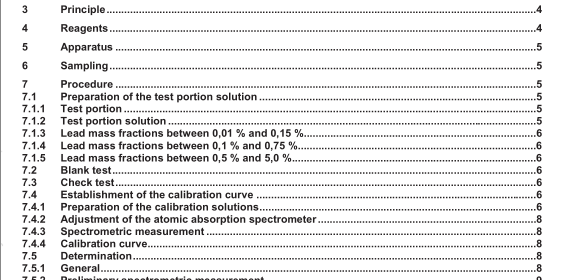EN 15622:2010 – Copper and copper alloys – Determination of lead content – Flame atomic absorption spectrometric method

7.1.2 Test portion solution
Transfer the test portion (7.1.1) into a 250 ml polytetrafluorethylene, polyethylene or polypropylene beaker (5.1). Add 40 ml of the fluoroboric-nitric acid mixture (4.5). Cover with a watch glass and heat gently until the test portion is completely dissolved, then heat at a temperature of approximately 90 °C until brown fumes have been expelled. If polyethylene or polypropylene beakers are used, heating shall be carried out in water bath. Wash the cover and the sides of the beaker with water and allow to cool. Transfer the dissolved test portion quantitatively into a 100 ml one-mark volumetric flask, dilute the solution to the mark with water and mix well.
7.1.3 Lead mass fractions between 0,01 % and 0,15 % Proceed as indicated in 7.5.
7.1.4 Lead mass fractions between 0,1 % and 0,75 % Take a 20 ml aliquot of the test portion solution (7.1.2) and introduce into a 100 ml one-mark volumetric flask. Dilute to the mark with water and mix well. Proceed as indicated in 7.5.
NOTE The validation exercise of this standard method showed that for lead mass fractions between 0,5 % and 0,75 % results are better when the determination is carried out following 7.1.4.
7.1.5 Lead mass fractions between 0,5 % and 5,0 % Take a 20 ml aliquot of the test portion solution (7.1.2) and introduce into a 500 ml one-mark volumetric flask. Dilute to the mark with water and mix well. Proceed as indicated in 7.5. 7.2 Blank test Carry out a blank test simultaneously with the determination, following the same procedure and using the same quantities of all reagents, as used for the determination, but omitting the test portion.
7.3 Check test Make a preliminary check of the apparatus by preparing a solution of a reference material or a synthetic sample containing a known amount of lead and of composition similar to the material to be analysed. Carry out the procedure specified in 7.5.
7.4 Establishment of the calibration curve
7.4.1 Preparation of the calibration solutions
7.4.1.1 General In all cases, copper, salt-concentrations and acidity in the calibration solutions shall be similar to those of the test portion solutions. The presence of copper in the calibration solutions compensates for chemical interaction effects of copper in the test solution. Normally no similar additions are required to compensate for the effect of alloying elements. If an alloying element is present in the material to be analysed in mass fraction > 10 %, an appropriate mass of this element shall be added to the calibration solutions. The volumes of copper base solution added (4.8) have been calculated to compensate for chemical interaction effects of copper in test solutions of copper or high-copper alloys.
Overcompensation may occur if the same volumes are added when the test samples are copper-based alloys where the percentage of copper is lower. In these cases, the volumes of copper base solution shall be decreased to match the copper content of the test sample in solution.
EN 15622:2010 – Copper and copper alloys – Determination of lead content – Flame atomic absorption spectrometric method